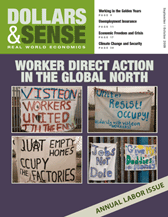Comment
Another Road to Recovery
On environment, living standards, and jobs, public transportation is a winner.
This article is from the September/October 2009 issue of Dollars & Sense: Real World Economics available at http://www.dollarsandsense.org

This article is from the September/October 2009 issue of Dollars & Sense magazine.
Subscribe Now
at a 30% discount.
Driving across the state of Massachusetts in recent weeks, I noticed various highway projects with signs nearby reading “A Project of the American Recovery and Reinvestment Act,” the stimulus bill passed by the Obama administration in February. These types of “shovel-ready” projects were rapidly implemented with recovery dollars designated for transportation. But capital improvements to public transportation are also eligible for those transportation dollars, which could be going to purchase new fleets of fuel-efficient buses and expand light-rail, subway, and other types of mass transit. Directing recovery spending into public transportation in the United States would have lasting impacts for our environment and our economy.
Transportation, according to the U.S. Environmental Protection Agency, is responsible for 34% of total U.S. carbon emissions. Private transportation makes up 61% of that. By shifting from private to public transportation, at least for a fraction of our commutes, we could significantly reduce the human impact on our climate. Switching from private vehicles to mass transit would achieve a 45% reduction in carbon emissions per passenger mile, according to the Energy Information Administration and the American Public Transportation Authority.
By increasing their use of public transportation, households would see cost savings and higher living standards. Low-income households in urban areas could particularly benefit from this shift. Improving public transportation in urban centers to between 25% and 50% of total transportation could lower costs and raise living standards for low-income households by 1% to 4%. The biggest savings are for those families that can reduce the number of vehicles they own. By getting rid of one car and using more mass transit, families can save on average $2,000 per year—the cost not only of gas but also vehicle maintenance, insurance, and financing.
Increasing our use of public transportation is not simply something we can do as individuals. In many cases it will also require infrastructure changes. While many bus and train lines have low ridership and could easily increase their passenger numbers, in other cases transit lines are inadequate or non-existent. Recovery dollars, along with continued public infrastructure spending, need to target the expansion of public transportation. Using mass transit will not be popular if it’s not convenient. Therefore in less densely populated areas we’ll need more bus lines. In more densely populated areas we might need buses to run more frequently. The same holds true for rail, subway, and other forms of mass transit. Of course, simply putting more buses on the road will not benefit our environment if they are gas-guzzling monsters. We must ensure that new buses be electric-powered, clean-diesel, or otherwise low-carbon.
Expanding public transportation not only reduces our carbon emissions while increasing our living standards, it also creates jobs: bus drivers and dispatchers, mechanical engineers and office administrative staff, assembly and managerial jobs in the plants that manufacture the vehicles. Buying new buses and building new rail lines will employ thousands of workers with a wide variety of credentials, from those who have a high-school diploma to those with an advanced degree. At a time when our country is approaching double-digit unemployment, and when many more people are under-employed (working fewer hours than they would like to), an investment in public transportation could provide a much-needed economic stimulus. It will create jobs, improve our living standards, and put us on the road toward greater sustainability.
